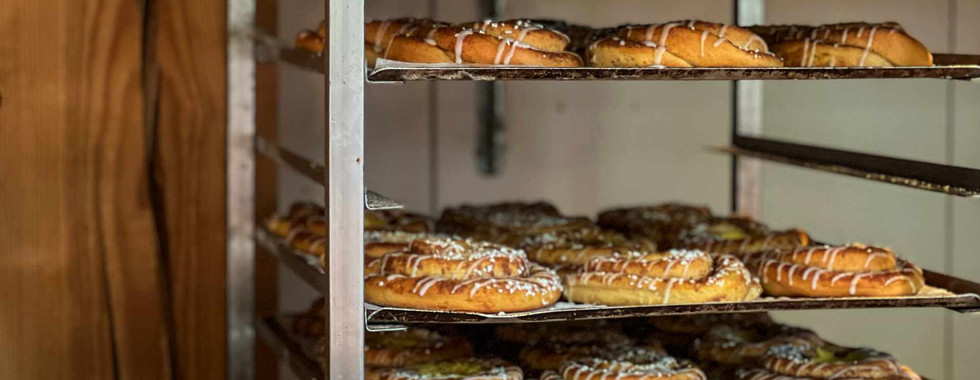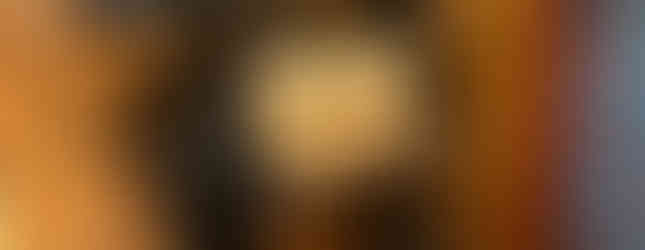(7)Day Seven: The Most Delicious Cardamom Breakfast - On the Way to a Vanishing Glacier
- Elflilja
- Sep 14, 2024
- 6 min read
Updated: Oct 13, 2024
On this day, I didn't leave breakfast to chance! Months earlier, I had picked out a trendy little bakery in Lom, nestled in a truly charming spot. Imagine this: from the terrace, you can see a stream that looks like a Norwegian painting brought to life.
The only catch was the painting was full of people. Crowds. I thought Scandinavians slept in, but at 9 AM, there was almost a pilgrimage for the cardamom pastries, and of course, we joined the line. This is where the problems started: we didn't quite get that we had to order coffee at the counter where the pastries were, since we didn't see a coffee machine anywhere. As amateur tourists, we wandered confusedly around the coffee counter further along, like the northern lights on an exceptionally cloudy night. Stand in line again? In this humid weather? No way. So we left the "sacred place" and continued our journey in the air-conditioned car.

We hadn't eaten breakfast before setting out because I was sure we could have coffee at the bakery. So we soon had to stop again to finally grab a bite. Near Nordberg, we found a camping rest area (Nasjonalpark kiosken), where we thought there would be coffee (a sign indicated it) – but of course, it was closed.
We finally had our breakfast on a cozy little bench by the Heggjebottvatnet lake. It wasn't bad, in fact, the cardamom pastry lived up to expectations – the love story between Norway and cardamom continued here too. I love this spice; it felt like I was biting straight into my heart in the middle of nature. :)
However, a bathroom break would have been nice, but the local "comfort" leaned more toward the horror category. This was probably the worst bathroom of the trip. Generally, the more "sightseeing-type" foreign (non-Scandinavian) tourists there were in one place, the more awful the bathroom was. But this one owed its horrors to the fact that it wasn't separated by gender but by use: a peeing section (for men) and a pooping section (for everyone else). We quickly moved on...
At Pollfoss, we found an interesting hotel and rest area where we could finally use the bathroom in humane conditions. But the best part? The seemingly abandoned hotel felt like a time machine – old furniture, a vintage atmosphere, a real little treasure chest. Of course, there were a few more stops after this because, well, Norway!
This section of the journey took us through several smaller and larger tunnels. Around Lake Grotli, the view took our breath away. The crystal-clear water and the sight of the mountains felt like stepping into a living landscape painting. We even saw people sunbathing on camping chairs, as if we had arrived at the most peaceful place in the world.
Then came the area around Hjelledalen, where sheep grazed peacefully in the valley among beautiful black houses, surrounded by mountains and waterfalls. It was almost a fairy-tale sight, with the light drizzle.
Around 2 PM, we finally reached the day's main attraction: the Briksdalsbreen Glacier! The road there from Loen ran alongside the Oldevatnet lake, with some quite narrow one-lane sections, like a prehistoric amusement park.
The Oldevatnet is a unique lake formed by meltwater, and its water is so vivid blue that you'd think someone photoshopped it. Even though we started the glacier hike feeling a bit tired, the view was worth everything!
As we approached the glacier, the drizzling rain began to dissipate, and when we arrived, the sky was clear. Peter, who was a bit grumpy at first, suddenly felt much better when he saw the massive ice block. And of course, I motivated him: "Since we're here, let's see this wonder because who knows how much longer it will be visible!" And truly – glaciers are continuously shrinking due to climate change. Just look at this old photo from 1989: Briksdalsbreen Glacier 1989.
The way back was even more beautiful; we crossed a bridge where a waterfall sprayed us. A raincoat would have been useful, but instead, we just laughed in the misty water and took a selfie. (We actually hate taking selfies.) And of course, the sight of troll cars couldn't be missed! The carts departing from the parking lot carried screaming Chinese tourists wrapped in rain-protective blankets – it was such a funny sight!
On the way back, we stopped again by the Oldevatnet lake and marveled at the water. It was truly a special experience. Imagine, on the other side of the mountain lies another similarly beautiful lake, the Lovatnet. And there are two other glaciers hidden here, the Ramnefjellsbreen and the Kjenndalsbreen. Unfortunately, we didn't have time to explore these; it would have taken days to wander the area.
But off to Runde Island! By late afternoon, we were so tired that we could hardly wait to get there. We even got caught in a heavy rain, fortunately while driving. When we arrived in the evening and it was still light, we couldn't resist: we had to go up to the bird cliffs in hopes of finally seeing a real puffin! Peter was very interested, and I've been dreaming of these flying, penguin-like cuties since childhood.
Of course, we first set off in the wrong direction, down a long road, heading towards the Runde Lighthouse. This iconic lighthouse, built in 1767, is a remarkable sight, but unfortunately, the road to it would have been too long. So we admired it from afar and were not disappointed: the sunset and the surrounding Norwegian Sea were captivating. We even saw great skuas! The great skua (Stercorarius skua) is a medium-sized, brown-feathered seabird that inhabits areas near and in the sub-Arctic regions. A little later, of course, we got drenched due to a sudden rain, but the experience was worth everything. Fortunately, we had a shoe dryer with us!
And our accommodation? Perfect! A lovely little Airbnb apartment, with bird-themed bedding, a washing machine, and a small path from the garden leading directly to the tourist route. It was the most expensive accommodation of the trip, but it was worth it.
And so the day ended – we closed it tired but happy on Runde Island, filled with new experiences and memories we will never forget.
Fun Fact About the Great Skua:
The great skua is brown with darker and lighter shades. Adult birds have long, narrow wings and sharp, clawed feet. Young birds are grayish-brown and gradually change to their adult coloration. These birds mainly feed on fish and other marine life. They often steal food from other birds, such as puffins, to get their meals. They frequently engage in "kleptoparasitism," where they rob other birds of their prey. The great skuas breed in northern regions, where they nest in large colonies. They often use stones and other natural materials to build their nests. Both parents take turns incubating the eggs, and the chicks develop quickly. They are aggressive birds and defend their nesting sites. They often fly at high speed and screech loudly to ward off potential threats. In addition, they are well adapted to extreme weather conditions and strong winds.
Interesting Fact About the Briksdalsbreen Glacier:
The Briksdalsbreen is one of the largest glacier streams in the Jostedalsbreen system, which is considered Norway's largest glacier. Due to its accessibility, hiking to the glacier is relatively easy, with numerous marked trails and parking areas nearby. In front of the glacier lies a stunning ice stream that contains deep blue ice blocks. These ice blocks continuously break off as the glacier melts, creating an exciting and dynamic spectacle. The Briksdalsbreen Glacier is constantly monitored for the effects of climate change. Like many glaciers, it shows a decreasing size, indicating the impact of global warming. Its melting rate is also a crucial factor in climate change research. The surrounding areas have played an important role in the lives of local communities for centuries. They have a rich historical and cultural heritage and offer an opportunity to better understand Norway's natural and cultural values. The water from the glacier flows into the Oldevatnet lake, which is considered important for flood and water management. The glacier's water contributes to local hydroelectric power generation and plays a significant role in the surrounding ecosystem. Subglacial tunnels also form underneath it, providing a fascinating sight. These tunnels constantly change as the glacier moves and melts.
Thus, the Briksdalsbreen Glacier is not just a natural wonder but also a place where we can observe both the dynamics of nature and the effects of global climate change.







































































Comments